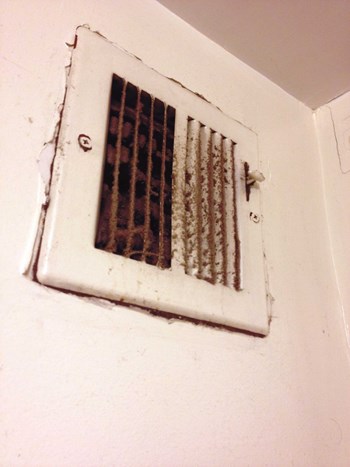
Few things are as important to our health and well-being as the air we breathe, especially inside our own homes. That is why it is so important for individual homeowners as well as management to stay up-to-date on issues of indoor air quality and ensure that everything possible is done to provide a healthy environment, especially in the winter months when so many of us are spending time in the warmth of the indoors.
Problem Areas
Staying warm is always priority one in the winter months. That desire to keep the cold out and the warmth in can lead to problems, though, with air quality. “Generally people seal out the cold which means their space is not getting enough fresh outdoor air. The indoor air then gets re-circulated too often causing some people to get more coughs and colds,” says Steve Gromala, of Altair Associates Inc., a construction management and consulting firm in Wheaton. “Air not moving at all could possibly create interior window condensation and frost. Sometimes opening curtains or blinds can alleviate window condensation to allow air movement.”
“During the winter months there may be an air balance issue,” adds Mike Sehring, an estimator with Riverside Mechanical Services in Frankfort.” You get a certain amount of air flow in rooms, and if a door or window is closed it would block that space off from the rest of the system. That could lead to overheating and under heating.”
“Windows and doors are typically closed during the winter months and if the air ventilation system isn’t in good condition or isn’t performing well, the air quality can get stuffy for the occupants and that can lead up to the buildup of carbon dioxide,” says David O’Dea, senior project manager for Bluestone Environmental Inc., a remediation company in Bridgeview. “People can get headaches and dizziness from a buildup of carbon dioxide. Carbon dioxide is a problem during the winter months.”
According to the Illinois Department of Public Health, carbon dioxide is a normal byproduct of exhaled breath and is commonly measured as a screening tool to evaluate whether adequate volumes of fresh air are being introduced into indoor air. If carbon dioxide levels are more than 1,000 ppm (parts per million), there is probably inadequate ventilation; and complaints such as headaches, fatigue, and eye and throat irritation may be prevalent. Properly-ventilated buildings should have carbon dioxide levels between 600 ppm and 1,000 ppm, with a floor or building average of 800 ppm. A high level of carbon dioxide may also indicate that other contaminants in the building may be present at elevated levels.
Experts also believe that carbon monoxide can be problematic in the wintertime because potential sources inside a building that may generate carbon monoxide include gas heating systems, gas stoves, gas hot water heaters and portable kerosene heaters, appliances which tend to get a workout during the winter months. Because carbon monoxide is colorless, odorless, tasteless and non-irritating, the signs of carbon monoxide exposure can be ignored, or a person may lose consciousness and be unable to escape. Carbon monoxide detectors can be purchased from any home improvement store and each home should have one.
In addition, spaces can be tested for radon, another potentially deadly gas that can occur naturally in soil and enter homes through cracked foundations, crawlspaces and basement drains. Illinois Department of Public Health guidelines for indoor air quality state that radon and uranium and its decay products are commonly found in soil and rock in Illinois.
On a less severe note, during the winter months, moisture can be a problem in homes. “When moisture infiltrates a building it makes the building materials wet and that’s when mold grows,” says O’Dea, “If no one does anything about it, the mold can grow in ventilation systems and that’s how those mold spores are delivered to the openings. On the other hand a lot of buildings become really dry in the winter and that’s because of low relative humidity.”
Other irritants include dust as well as construction debris found in homes that have never had the vents cleaned. “Homes with air quality issues generally have continuous leaks somewhere, usually in the basement, roofs or windows,” says Gromala. “Homes with pets or people with allergies may want to invest in better filters.”
Signs of indoor air quality issues include heavy dust on the furnace filter; heavy dust build-up on the return vents; dust and black lines around the air ducts; dust build-up on furniture; debris such as insect bodies and food particles in floor vents; and odor coming from vents.
Homeowners, unit owners and shareholders who suffer from allergies and chronic sinus issues may also be showing signs of indoor air quality in the home. Symptoms resulting from seasonal air quality changes may range from sneezing and nasal or eye irritations to coughing, drowsiness and headache. Individual allergic reactions to mold or pollen, for example, may be severe depending on sensitivity.
“If the filter in the furnace is getting dirty regularly or you see condensation on the windows it shows that it’s too humid and those are signs of poor air quality,” says Sehring.
Built-in Issues
Sometimes indoor air quality issues stem from chemicals and other products introduced into the building for construction, cleaning or similar activities.
In addition, the type and location of a building can impact air quality. “A lot of buildings created over the last 20 or 30 years are very tightly constructed,” says O’Dea. “A lot of office buildings are glass and steel are buttoned up pretty tight. Windows aren’t opening so pollutants tend to stay in the building and there’s not a lot of air filtration. Alternatively in an older, draftier building, say one that was built in the ‘20s or ‘30s with those old windows, they can be draftier but better for air quality, because there is more air infiltration and they are just not as tightly constructed.”
“If walls are painted with lead paint that could lead to asbestos and with that comes a host of problems,” adds Sehring. “Believe it or not, I come across a lot of lead paint in schools—and there’s a lot of asbestos in the floor tiles of Chicago schools as well. Lead paint is very common in older buildings in the Chicago area. It won’t hurt you unless you scratch it, but it certainly affects air quality.”
The location of a building can also contribute to air problems. “Some buildings can be located near air pollution sources such as above trains, next to a truck terminal or near a highway where there is a lot of pollution from cars and trucks that can enter a building from the air,” says O’Dea. “As a result of that air pollutants like carbon monoxide can easily enter a building.”
Cleaning liquids can also contribute to indoor air problems by releasing volatile organic compounds (VOCs). “This happens more often than you think. If everyone is suddenly getting sick in a building and then you discover that a new carpet cleaner was used in the lobby, it was probably releasing volatile organic compounds,” says O’Dea.
When it comes to chemicals and other unusual causes of air quality issues, the concept of “sick building syndrome” may come to the fore, but experts have mixed feelings on the subject.
“Sick buildings exist but they are very rare,” says Gromala. “From my experience they are caused by still water continuously pooling in ductwork or in ductwork insulation.”
“Sick building syndrome is a very real thing and they are more common than people think,” says O’Dea. “This happens with poorly constructed buildings. Say you have a building built next to a train station or a loading dock and the fresh air intake is poorly designed where it’s near the pollution source. Another culprit for sick building syndrome is the presence of mold.”
Avoiding & Solving Problems
In any situation, the best way to solve a problem is to prevent it from happening in the first place. Homeowners should have their air ducts cleaned by a professional air duct cleaner every two to five years. And it is important to ensure that the cleaners are experienced.
Other preventive measures should include keeping furnace filters clean and replacing them often and vents, ducts, and air handling units should be routinely inspected at a minimum of once a year depending on usage.
However, any incidence involving water damage, mold or microbial growth, building of dust or debris, or severe odors coming from the ventilation system should prompt an inspection from an indoor environmentalist specialist.
“When we conduct inspections we are looking for two things: we are looking for an indoor source or air pollutants and we’re also looking at the ventilation system to make sure it’s not contaminated,” says O’Dea. “We also interview the occupants and ask them questions like ‘What type of symptoms are you experiencing?’ ‘When are you experiencing them?’ ‘Do you experience them all day long or does it go away when you leave the building?’ We also interview the property manager and ask if there’s been any alterations in the building like cleaning products or if there has been any recent construction or renovation work.”
For boards and property managers, it is important to maintain not only a regular maintenance and testing schedule for the building, its equipment and its environment but also to ensure an open dialogue with residents.
In short, when it comes to maintaining a healthy indoor environment and finding a way to feel confident in the air we breathe, proper monitoring, effective education and quick maintenance and repair are imperative. Stay clean, keep dry, learn more, follow maintenance standards and then, just breathe easy.
Liz Lent is a freelance writer and a frequent contributor to The Chicagoland Cooperator. Staff Writer Christy Smith-Sloman contributed to this article.






Leave a Comment